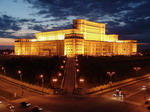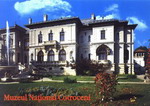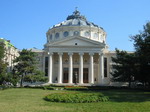Bucharest & Romania
Bucharest (Romanian: București) is the capital city and the commercial centre of Romania. It is located in the southeast of the country, at 44°25′N 26°06′E, and lies on the banks of the Dambovita River.
The city was first mentioned in 1459 and became the capital of Romania in 1862. Since then, it has gone through a variety of changes and has become the centre of the Romanian mass media, cultural and arts scene.
Its eclectic architecture, which is a mix of historical, Ceausescu-era and modern, also reflects the city’s varied history. In the period between the two World Wars, the city’s elegant architecture and the sophistication of its elite gave Bucharest the nickname of the "Paris of the East" or "Little Paris".
Although much of the historic center was damaged or destroyed by war, earthquakes and Nicolae Ceausescu’s program of systematization, much survived, and in our days the city is experiencing an economic and cultural boom.
Must see in Bucharest
Here is a selection of the most representative land-marks of Bucharest witch are a must to see during your stay in the city. You will see these and much more one of our regularly scheduled or customized tours while benefiting from the expertise and knowledge of our experienced lincenced guides.
The Parliament Palace Is the second largest administrative building in the world (after the Pentagon) in terms of all-out surface:330.000 m2. It was built between 1984 and 1989 by a team of architects led by Anca Petrescu and was destinded for the members of the Communist Party; Besides offices, Ceausescu planned to make personal living places, so the Palace’s surface would have been bigger. The building currently houses Romania’s Parliament.
Is the second largest administrative building in the world (after the Pentagon) in terms of all-out surface:330.000 m2. It was built between 1984 and 1989 by a team of architects led by Anca Petrescu and was destinded for the members of the Communist Party; Besides offices, Ceausescu planned to make personal living places, so the Palace’s surface would have been bigger. The building currently houses Romania’s Parliament.
Visiting hours: 10 a.m. - 4 p.m., Tuesday through Sunday (By appointment only).
The Cotroceni Palace Is a part of the Cotroceni National Museum. The Cotroceni Palace, church and monastery reflect a three-century old history that interweaves political, military, diplomatic, religious and cultural aspects, with the general evolution of Romanian society. The palace was built in the 17th century by the prince Serban Cantacuzino. The Cotroceni National Museum exhibits a rich range of objects of art, illustrative of the Romanian decorative art. The Cantacuzino space is most suitable for organizing presentations of old art objects that can only out-line the exceptional artistic accomplishments of a distant epoch.
Is a part of the Cotroceni National Museum. The Cotroceni Palace, church and monastery reflect a three-century old history that interweaves political, military, diplomatic, religious and cultural aspects, with the general evolution of Romanian society. The palace was built in the 17th century by the prince Serban Cantacuzino. The Cotroceni National Museum exhibits a rich range of objects of art, illustrative of the Romanian decorative art. The Cantacuzino space is most suitable for organizing presentations of old art objects that can only out-line the exceptional artistic accomplishments of a distant epoch.
Visiting hours: 10 a.m. - 5 p.m., Tuesday trough Sunday (By appointment only).
The Village Museum Nestled on the shore of the Herastrau Lake, the museum displays 85 peasant homes, barns, churches and mills relocated there from all over Romania. Tall-roofed Transylvanian houses with beautifully crafted shingles sit alongside rustic wooden churches to form a unique neighborhood. The overall impression is that Romanian peasants take great pride in their work and homes. Everyday accessories: tools, butter-churns, hay forks, beer kegs and clothes are displayed inside the house. This museum can take a whole day to explore and, in fine weather, families settle down for picnics in the scenic grounds.
Nestled on the shore of the Herastrau Lake, the museum displays 85 peasant homes, barns, churches and mills relocated there from all over Romania. Tall-roofed Transylvanian houses with beautifully crafted shingles sit alongside rustic wooden churches to form a unique neighborhood. The overall impression is that Romanian peasants take great pride in their work and homes. Everyday accessories: tools, butter-churns, hay forks, beer kegs and clothes are displayed inside the house. This museum can take a whole day to explore and, in fine weather, families settle down for picnics in the scenic grounds.
Visiting hours: 10 a.m. - 6 p.m., every day, except Monday.
The National Museum of Art Is hosted by the former Royal Palace and is the most representative art gallery in Romania. The Royal Palace was the official residence of the Romanian kings. Its current facade was given the finishing touches in 1937 when Carol II was King of Romania. The National Art Museum Palace is located in down-town Bucharest (in the so-called Revolution Square). The Palace displays an extensive collection of European and Romanian fine art. The European Art Gallery offers an overview of the most important artistic movements that marked art history from the early Rennaissance till the first decades of the 20th century. The Romanian Modern Art Gallery illustrates the development of Romanian fine arts from the first decades of the 19th century till the second half of the 20th century.
Is hosted by the former Royal Palace and is the most representative art gallery in Romania. The Royal Palace was the official residence of the Romanian kings. Its current facade was given the finishing touches in 1937 when Carol II was King of Romania. The National Art Museum Palace is located in down-town Bucharest (in the so-called Revolution Square). The Palace displays an extensive collection of European and Romanian fine art. The European Art Gallery offers an overview of the most important artistic movements that marked art history from the early Rennaissance till the first decades of the 20th century. The Romanian Modern Art Gallery illustrates the development of Romanian fine arts from the first decades of the 19th century till the second half of the 20th century.
Visiting hours: Wednesday through Sunday
11 a.m. - 7 p.m. (May -September)
10 a.m. - 6 p.m. (October - April)
Closed: Monday, Tuesday
The Romanian Atheneum Is a concert hall in the center of Bucharest and a landmark of the Romanian capital city. Opened in 1888, the ornate, domed, circular building in the city’ s main concert hall and home of the "George Enescu" Philarmonic and of the "George Enescu" annual international music festival. It has the aspect of a Greek temple with Ionic columns at the entrance. The wonderful interior with round frescoes depicts important events in Romania’s history. Extensive reconstruction and restoration work has been conducted in 1992 by a Romanian construction company and restoration painter Silviu Petrescu, saving the building from collapse.
Is a concert hall in the center of Bucharest and a landmark of the Romanian capital city. Opened in 1888, the ornate, domed, circular building in the city’ s main concert hall and home of the "George Enescu" Philarmonic and of the "George Enescu" annual international music festival. It has the aspect of a Greek temple with Ionic columns at the entrance. The wonderful interior with round frescoes depicts important events in Romania’s history. Extensive reconstruction and restoration work has been conducted in 1992 by a Romanian construction company and restoration painter Silviu Petrescu, saving the building from collapse.
Visiting hours: every day, unless concerts or rehearsals are held.
The Old Royal Court During the early Middle Ages, Bucharest became a commercial center; important enough to enable the XIV century princes to build the Princely Court - nowadays known as "The Old Court"- which formed the development core of the medieval town. The first written mention of the name of "Bucharest" dates back to September 20, 1459: it appears on a document issued from the chancellery of the famous Prince Vlad Tepes (the Impailer). By the year 1599, a new Princely Court was built. Matei Basarab (1632 - 1654) renovated the Old Court. By 1640, because the prince’s relations with the Turks worsened, Matei Basaab moved his Capital back to the town of Targoviste. Bucharest still remained a princely residence. In May 1654, Prince Constantin Serban Basarab (1654-1658), Matei Basarab’s successor, left for Targoviste after a rebellion of his mercenary troops, and he ordered the Old court to be set of fire. The Old Royal Court is an outdoor site that can be visited any time.
During the early Middle Ages, Bucharest became a commercial center; important enough to enable the XIV century princes to build the Princely Court - nowadays known as "The Old Court"- which formed the development core of the medieval town. The first written mention of the name of "Bucharest" dates back to September 20, 1459: it appears on a document issued from the chancellery of the famous Prince Vlad Tepes (the Impailer). By the year 1599, a new Princely Court was built. Matei Basarab (1632 - 1654) renovated the Old Court. By 1640, because the prince’s relations with the Turks worsened, Matei Basaab moved his Capital back to the town of Targoviste. Bucharest still remained a princely residence. In May 1654, Prince Constantin Serban Basarab (1654-1658), Matei Basarab’s successor, left for Targoviste after a rebellion of his mercenary troops, and he ordered the Old court to be set of fire. The Old Royal Court is an outdoor site that can be visited any time.









